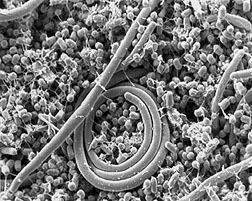| 
Salmonella enteritidis. Click the image for
more information about it.
Read the
magazine
story to find out more.
|
Salmonella Can Cause Poorer Eggshell Quality
By Sharon
Durham
October 4, 2004 A decrease in eggshell quality is a
trait that may be used to detect chickens infected with Salmonella,
according to Agricultural Research
Service scientists.
Veterinary medical officer Jean Guard Bouldin, at the ARS
Southeast Poultry Research Laboratory
in Athens, Ga., found an interesting phenomenon--not only was Salmonella
present inside chicken eggs, but other bacteria were there also. Since these
bacteria are usually seen in eggs that have been contaminated through cracks in
the shell, Bouldin theorized that poor eggshell quality allowed the bacteria to
enter the egg.
Salmonella enteritidis is hard to detect in chickens because there
are no symptoms. This poses a significant problem, because S.
enteritidis, found inside the egg, is an important cause of human
food-borne illness.
Bouldin and Jeff Buhr, of the ARS Poultry Processing and Meat Quality Research
Unit in Athens, Ga., conducted tests in which chickens were inoculated with
S. enteritidis. Eggs were then tested for hardness by compressing them
until a hairline crack formed. Eggs from Salmonella-infected hens
cracked easier than those from noninfected hens. Other research has shown that
some strains of S. enteritidis seem to target the hen's reproductive
tract, which appears to result in an egg with a less resilient shell, according
to Bouldin.
At low-dose infection, Bouldin found that S. enteritidis actually
stimulated egg production, particularly in older hens. This increased
production may have stretched the limited eggshell material--calcium--a bit too
thin, literally.
Other diseases of chickens can also decrease shell quality, but usually they
result in a decrease in production and illness in hens. Changes to eggshell
quality over the lifespan of a laying hen are to be expected, and thus a hen's
age could be an additional risk factor.
Read
more about this research in the October 2004 issue of Agricultural
Research magazine.
ARS is the USDA's chief scientific
research agency.
|